Abstract
Binding of [3H]cimetidine to rat brain tissue was investigated, and a saturable binding with dissociation constant 0.22±0.05 μM found. This binding is inhibited by a range of imidazole-derived histamine H2-receptor antagonists, but not by a number of non-imidazole H2-receptor antagonists. It is concluded that the [3H]cimetidine binding site in rat brain tissue that is labelled in these experiments is not the histamine H2-receptor.
Similar content being viewed by others
References
M. Chasin, F. Mamrak, S.G. Samaniego andS.M. Hess,Characteristics of the Catecholamine and Histamine Receptor sites Mediating Accumulation of Cyclic Adenosiee 3′,5′-Monophosphate in Guinea-Pig Brain, J. Neurochem.21, 1415 (1973).
K. Dismukes, M. Rogers andJ.W. Daly,Cyclic Adenosine 3′,5′-Monophosphate Formation in Guinea-Pig Brain Slices: Effect of H 1 -and H 2 -Histaminergic Agonists, J. Neurochem.26, 785 (1976).
J.M. Palacios, M. Garbarg, G. Barbin andJ.C. Schwartz,Pharmacological Characterization of Histamine Receptors Mediating the Stimulation of Cyclic AMP Accumulation in Slices from Guinea-Pig Hippocampus, Mol. Pharmacol.14, 971 (1978).
J.P. Green, C.L. Johnson, H. Weinstein andS. Maayani,Antagonism of Histamine-Activated Adenylate Cyclase in Brain by D-Lysergic Acid Diethylamide, Proc. nat. Acad. Sci USA74, 5697 (1977).
P.D. Kanof andP. Greengard,Pharmacological Properties of Histamine-Sensitive Adenylate Cyclase from Mammalian Brain, J. Pharmac. exp. Ther.209, 87 (1979).
S.R. Nahorski, K.J. Rogers andB.M. Smith,Stimulation of Cyclic Adenosine 3′,5′-monophosphate in Chick Cerebral Hemisphere Slices: Effects of H 1 and H 2 Histaminergic Agonists and Antagonists, Brain Res.126, 387 (1977).
S.J. Hill, P.C. Emson andJ.M. Young,The Binding of [3H]mepyramine to Histamine H 1 -Receptors in Guinea Pig Brain, J. Neurochem.31, 997 (1978).
R.S.L. Chang, V.T. Tran andS.H. Snyder,Heterogeneity of Histamine H 1 -Receptors: Species Variations in [3 H]mepyramine Binding of Brain Membranes, J. Neurochem.32, 1653 (1979).
V.T. Tran, R.S.L. Chang andS.H. Synder,Histamine H 1 -Receptors Identified in Mammalian Brain Membranes with [3 H]mepyramine, Proc. nat. Acad. Sci. USA75, 6209 (1978).
M. Rehavt andM. Sokolovsky,Multiple Binding Sites of Tricyclic Antidepressant Drugs to Mammalian Brain Receptors, Brain Res.149, 525 (1978).
W.P. Burkard,Histamine H 2 -Receptor Binding with [3 H]metidine in Brain, Eur. J. Pharmac.50, 449 (1978).
D.A. Kendall, J.W. Ferkany andS.J. Enna,Properties of [3 H]cimetidine Binding in Rat Brain Membrane Fractions, Life Sciences26, 1293 (1980).
G.N. Wilkinson,Statistical Estimations in Enzyme Kinetics, Biochem. J.80, 324 (1961).
R.J. Lefkowitz, L.E. Limbird, C. Mukherjee andM.G. Caron,The β-Adrenergic Receptor and Adenylate Cyclase, Biochim. Biophys. Acta457, 1 (1976).
T.O. Yellin, S.H. Buck, D.J. Gilman, D.F. Jones andJ.M. Wardleworth,ICI 125, 211: a Potent New Antisecretory Drug Acting on Histamine H 2 -Receptors, The Pharmacologist21, 266 (1979), Abstract 635.
J. Bradshaw, R.T. Brittain, J.W. Clitherow, M.J. Daly, D. Jack, B.J. Price andR. Stables,Ranitidine (AH 19065): a New Potent, Selective Histamine H 2 -Receptor Antagonist, Br. J. Pharmac.66, 464P (1979).
J.P. Green andS. Maayani,Tricyclic Antidepressant Drugs Block Histamine H 2 -Receptor in Brain, Nature, Lond.269, 163 (1977).
P.D. Kanof andP. Greengard,Brain Histamine Receptors as Targets for Antidepressant Drugs, Nature, Lond.,272, 329 (1978).
M.E. Parsons, D.A.A. Owen, C.R. Ganellin andG.J. Durant,Dimaprit-[S-]3(N,N-dimethylamino)-propylisothiourea] — A Highly Specific Histamine H 2 -Receptor Agonist,Agents and Actions7, 31 (1977).
G.J. Durant, W.A.M. Duncan, C.R. Ganellin, M.E. Parsons, R.C. Blakemore andA.C. Rasmussen,Impromidine (SK&F 92676) is a very Potent and Specific Agonist for Histamine H 2 -Receptors, Nature, Lond.276, 403 (1978).
S.T. Nielsen, T.O. Yellin, P.N. Edwards andM.S. Large,Radioligand Binding Assay of H 2 -Receptors with [3 H]ICIA 5165, The Pharmacologist21, 265 (1979), Abstract 634.
C.R. Ganellin,Selectivity and the Design of Histamine H 2 -Receptor Antagonists, J. appl. Chem. Biotechnol.28, 183 (1978).
Author information
Authors and Affiliations
Rights and permissions
About this article
Cite this article
Smith, I.R., Cleverley, M.T., Robin Ganellin, C. et al. Binding of [3H]cimetidine to rat brain tissue. Agents and Actions 10, 422–426 (1980). https://doi.org/10.1007/BF01968040
Received:
Issue Date:
DOI: https://doi.org/10.1007/BF01968040




